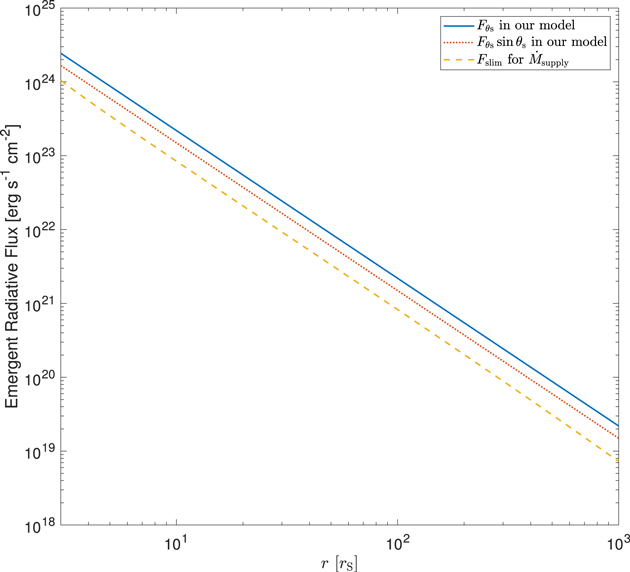Dr. JIAO Chengliang, from Binaries & Variables Group in Yunnan Observatories, Chinese Academy of Sciences, studied the advective energy transport in super-Eddington accretion using a new two-dimensional inflow-outflow solution with radial self-similarity. They discovered that radial advection is a heating mechanism in the inflow due to compression, and the energy balance in the inflow is maintained by cooling via radiation and vertical (θ-direction) advection, which transports entropy upward to be radiated closer to the surface or carried away by the outflow. As a result, photon trapping in the flow is inhibited, and the radiative efficiency of super-Eddington accretion becomes higher than that expected by the slim-disk model, which agrees with the results of some recent numerical simulations. The research was recently published online in the Astrophysical Journal.
The Eddington luminosity is the maximum luminosity a spherically accreting body, such as stars, where outward radiative force balances inward gravitational force. Accretion disks with very high mass accretion rates, known as super-Eddington accretion flows, can exceed this limit. Recent observations suggest that most ultraluminous X-ray sources (ULXs) may result from super-Eddington accretion with powerful outflows. As the conventional model for super-Eddington accretion flows, the slim-disk model, does not consider the effects of outflow, their results become problematic and new models need to be constructed.
In this study, Dr. JIAO introduced a new 2D solution for super-Eddington accretion with radial self-similarity. Notably, the model incorporates the radiative flux equation and self-consistently calculates the advective factor, departing from previous studies. They find that radial advection is actually a heating mechanism in the inflow due to compression, and a cooling mechanism in the outflow due to expansion. While radiation helps to cool the inflow, it alone cannot maintain the energy balance, and the entropy from compression and viscous heating that is not cooled by radiation is then carried upward by vertical advection. Part of this entropy is released as radiation at higher latitudes, where photons can escape more easily, and the rest of the entropy is carried away by the outflow. They also find that more energy is cooled by radiation in their solution than in the slim-disk model, because vertical motion in the new solution carries photons toward the surface of the accretion flow, which effectively reduces the photon-diffusion time and consequently inhibits the photon trapping effect. This consequently leads to a higher radiative efficiency than the slim-disk model, which agrees with results of some recent numerical simulations.
This work is supported by the Natural Science Foundation of China.

Figure 1. Comparison of emergent radiative fluxes for the same mass-supply rate from the environment. The solid line represents the emergent radiative flux in the θ direction on the surface of the accretion flow in the new model, the dotted line represents emergent radiative flux of the new model corrected for a reduced emitting surface, and the dashed line represents the emergent radiative flux of the slim-disk model.
Contact:
JIAO Cheng-Liang
Yunnan Observatories, CAS
Email:jiaocl@ynao.ac.cn